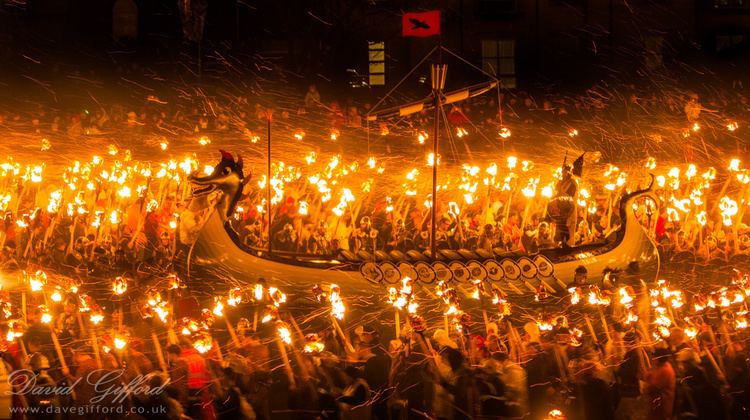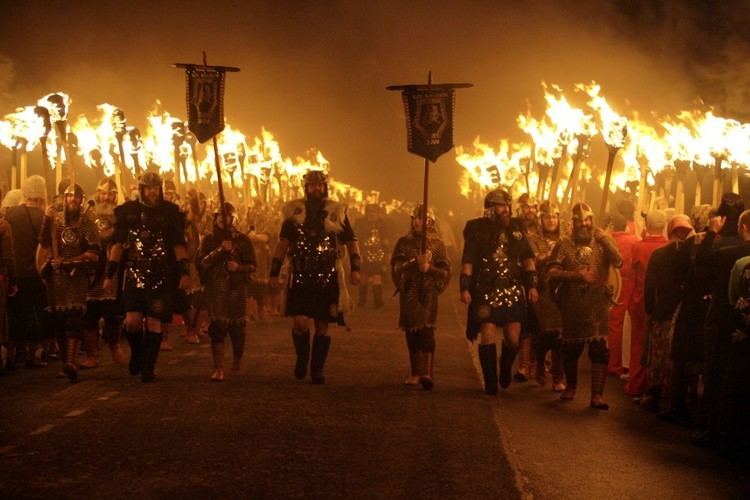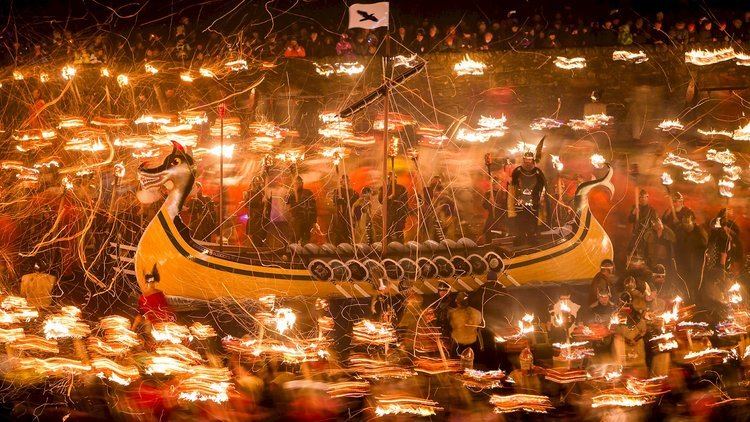 | ||
Up helly aa viking fire festival in shetland island scotland
Up Helly Aa (/ˈʌpˌhɛliə/ UP-hel-ee-ə; literally "Up Holy [Day] All") refers to any of a variety of fire festivals held annually in the Shetland Islands of Scotland, in the middle of winter to mark the end of the yule season. The festival involves a procession of up to a thousand guizers in Lerwick and considerably lower numbers in the more rural festivals, formed into squads who march through the town or village in a variety of themed costumes.
Contents
- Up helly aa viking fire festival in shetland island scotland
- Origins
- The modern event
- Meaning
- References

Origins

The current Lerwick celebration grew out of the older yule tradition of tar barrelling which took place at Christmas and New Year as well as Up Helly Aa. Squads of young men would drag barrels of burning tar through town on sledges, making mischief. After the abolition of tar barrelling around 1874–1880, permission was eventually obtained for torch processions. The first yule torch procession took place in 1876. The first torch celebration on Up Helly Aa day took place in 1881. The following year the torchlit procession was significantly enhanced and institutionalised through a request by a Lerwick civic body to hold another Up Helly Aa torch procession for the visit of the Alfred, Duke of Edinburgh. The first galley was introduced and burned in 1889. The honorary role of the 'Jarl' was introduced to the festival in the early twentieth century.
The modern event

There is a main guizer who is dubbed the "Jarl". There is a committee which a person must be part of for 15 years before one can be a jarl, and only one person is elected to this committee each year. The procession culminates in the torches being thrown into a replica Viking longship or galley. The event happens all over Shetland and is currently celebrated at ten locations – Scalloway, Lerwick, Nesting and Girlsta, Uyeasound, Northmavine, Bressay, Cullivoe, Norwick, the South Mainland and Delting. After the procession, the squads visit local halls (including schools, sports facilities and hotels), where private parties are held. At each hall, each squad performs its act, which may be a send-up of a popular TV show or film, a skit on local events, or singing or dancing.
Meaning
According to John Jamieson's Etymological Dictionary of the Scottish Language (1818), up is used in the sense of something being at an end, and derives from the Old Norse word uppi which is still used in Faroese and Icelandic, while helly refers to a holy day or festival. The Scottish National Dictionary defines helly, probably derived from the Old Norse helgr (helgi in the dative and accusative case, meaning a holiday or festival), as "[a] series of festive days, esp. the period in which Christmas festivities are held from 25th Dec. to 5th Jan.", while aa may represent a', meaning "all".


